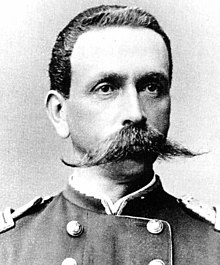
Manuel González de Candamo e Iriarte served as the 33rd President of Peru from 1903 until his death in 1904. He also served as Interim President of Peru,officially as the President of the Government Junta,from September 8,1903,until his death the following year.

Andrés Avelino Cáceres Dorregaray served as the President of Peru two times during the 19th century,from 1886 to 1890 as the 27th president,and again from 1894 to 1895 as the 30th. In Peru,he is considered a national hero for leading the resistance to Chilean occupation during the War of the Pacific (1879–1883),in which he fought as a general in the Peruvian Army.
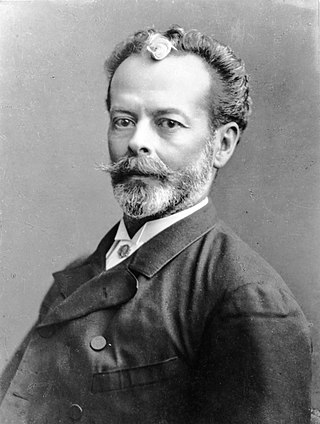
JoséNicolás Baltasar Fernández de Piérola y Villena was a Peruvian politician and Minister of Finance who served as the 23rd and 31st President of the Republic of Peru,from 1879 to 1881 and 1895 to 1899.

Mariano Ignacio Prado Ochoa was a Peruvian army general who served as the 17th and 21st President of Peru.
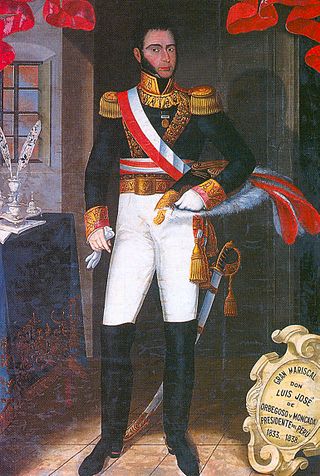
Luis Joséde Orbegoso y Moncada-Galindo,de Burutarán y Morales,was an aristocratic Peruvian soldier and politician,who served as the 5th President of Peru as well as the first President of North Peru. This was a time of profound social instability and continuing civil war which led his government to coexist with that of Pedro Pablo Bermúdez,and later with Felipe Santiago Salaverry.

Miguel Iglesias Pino de Arce was born on 11 June 1830 in Cajamarca,Peru,and died on 7 November 1909 in Lima,Peru. He was a Peruvian soldier,general,and politician who served as the 26th President of Peru from 1882 to 1885.
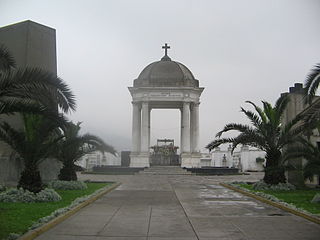
Presbyter Matías Maestro Cemetery,formerly the General Cemetery of Lima,is a cemetery,museum and historical monument located in the Barrios Altos neighbourhood of Lima District,in Lima,Peru. Inaugurated on May 31,1808,it was the first pantheon in the city since burials were previously held in the city's churches. It was named in honour of its designer,Spanish priest Matías Maestro.

The Battle of San Juan,also known as the Battle of San Juan and Chorrillos,was the first of two battles in the Lima Campaign during the War of the Pacific,and was fought on 13 January 1881. This battle is really a group of smaller,yet fierce confrontations at the defensive strongholds of Villa,Chorrillos,Santiago de Surco,San Juan de Miraflores,Santa Teresa and Morro Solar. The Chilean army led by Gen. Manuel Baquedano inflicted a harsh defeat on the Peruvian army commanded by the Supreme Chief Nicolás de Piérola. The Chilean triumph eliminated the first defensive line guarding Lima,and almost obliterated the Peruvian army defending it.

A Spanish Peruvian is a Peruvian citizen of Spanish descent. Among European Peruvians,the Spanish are the largest group of immigrants to settle in the country.

After the naval campaign of the War of the Pacific was resolved,the Chilean terrestrial invasion began.
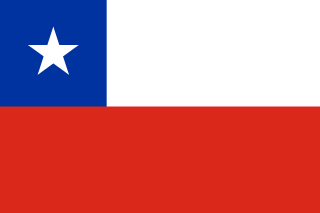
The Chilean occupation of Peru began on November 2,1879,with the beginning of the Tarapacácampaign during the War of the Pacific. The Chilean Army successfully defeated the Peruvian Army and occupied the southern Peruvian territories of Tarapacá,Arica and Tacna. By January 1881,the Chilean army had reached Lima,and on January 17 of the same year,the occupation of Lima began.

Pedro Bustamante y García (1825-1885) was a Peruvian Brigadier General of the War of the Pacific. He served as the Minister of War and Navy throughout various presidencies during the 1860s and 1870s. He was also known as the main commander during the Siege of Arequipa where he defeated the Conservative forces of Manuel Ignacio de Vivanco.
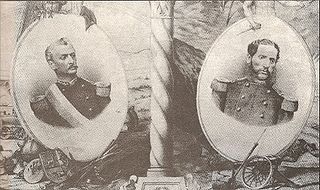
The Peruvian civil war of 1884–1885 was the sixth internal Peruvian conflict that erupted as a result of the ratification of the Treaty of Ancón,which ceded the Arica and Tacna provinces to Chile after the lost War of the Pacific.

The Peruvian Civil War of 1894–1895 was an internal conflict in Peru that lasted from October 1894 to March 1895,and was sparked by the election of Andrés Avelino Cáceres to the presidency of Peru,which was opposed by Nicolás de Piérola and his armed forces.

The Lima campaign is the third land campaign of the War of the Pacific,carried out by Chile between December 1880 and January 1881. The campaign ended with the Chilean occupation of the Peruvian capital and the establishment of the Chilean authority in it and other surrounding territories,which would extend until 1883,with the end of the war.

Arnaldo Panizo Avasolo was a Peruvian general of the 1857–1860 Ecuadorian–Peruvian War and the War of the Pacific as well as a key commander of the Lima campaign.

The name of National Reconstruction is given to the period following the War of the Pacific,which ended through the signing of the Treaty of Ancón on October 20,1883. It takes place between the civil wars of 1884–1885 and 1894–1895,when an economic,political and social resurgence took place. During this period,what was known as the Second Militarism took place,also known as the Militarism of the defeat in contrast to that which followed Peruvian Independence.

The Peruvian resistance movement was composed of the Peruvian militias and guerrillas commanded by local,civilian or military leaders,who confronted the Chilean Army and Navy during the period of occupation that took place during the War of the Pacific.

Manuel María Gálvez Egúsquiza was a Peruvian lawyer,magistrate,university professor and politician.

JoséAgustín Bedoya y Valle was a Peruvian colonel of the War of the Pacific. Being a primary organizer of the Breña campaign,he led the Peruvian forces at the Battle of San Jerónimo.
